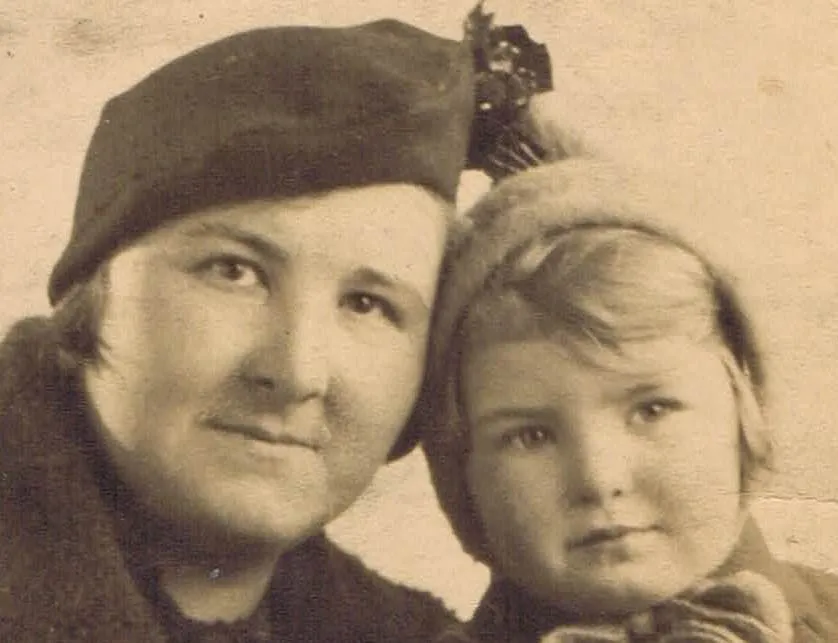Good morning — today’s story by Nick Booth is a gripping account of a German bombing raid which took place early on the morning of Christmas Eve, 76 years ago. At this time of the morning, it had just finished, and buildings were still burning across what is now Greater Manchester.
Nick first came across the story when he was writing his highly-acclaimed biography of the double agent Eddie Chapman, aka Zigzag who was used in the deceptions to alter the aiming for the V-1s. "I was intrigued by this last throw of the dice which ended up here in the north west," he says. "It's a fascinating story".
Thanks for reading, sharing and supporting The Mill this year, and Merry Christmas.

By Nicholas Booth
It was a cold Christmas Eve. A blanket of frost lay over Manchester that Sunday in 1944. In the suburb of Northenden — on the border with Didsbury — a little girl was fast asleep.
Suddenly, just before 5.20am, she became aware of a horrible noise in the darkness. Even as an eight-year-old, Margaret Appleby, knew what it was.
“All I can remember is that noise,” she says today. “I knew it was a doodlebug.”
Margaret jumped out of bed, then looked out of the window. “I couldn’t believe my eyes,” she says. “There was a V-1 and it seemed to be flying right in the centre of the road.”
Then came a heart-sinking moment. “The noise suddenly stopped.”
And that, Margaret knew, was when it would crash and explode. In the pre-dawn chill, she “flew” into her parents bedroom. “I said, ‘There’s a doodlebug and it’s stopped making this noise’,” she says, “and I jumped over the double bed!”
Margaret had experienced the first — and last ever — air-launched missile attack on Manchester. The doodlebugs, as the weapons had been christened, had hitherto mainly been fired at London and the South East. Now, as German propaganda would crow over the airwaves, “We have begun using the Vengeance weapons against Manchester.”
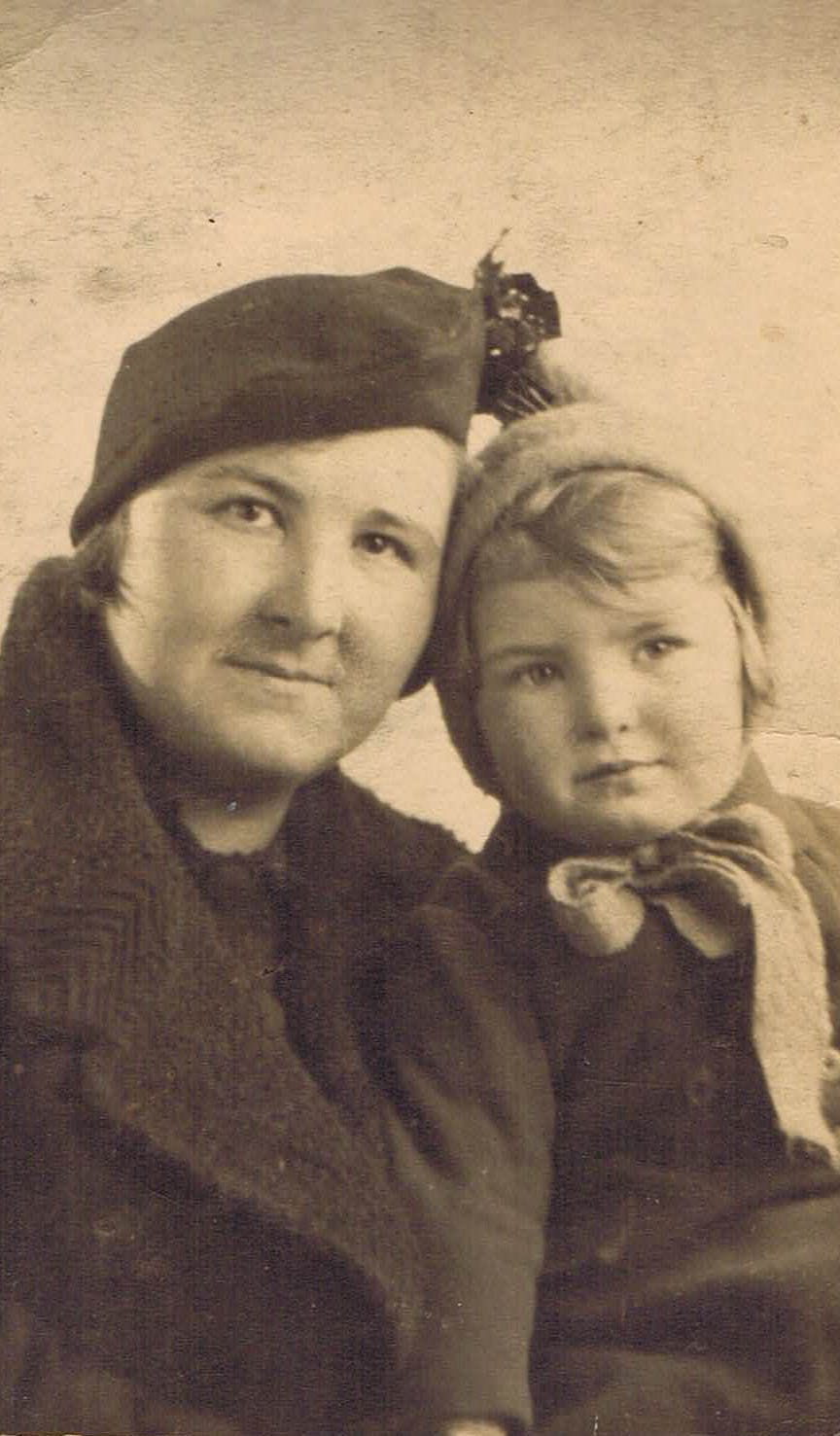
In the pre-dawn chill, forty five missiles had been launched from specially-adapted bombers off the coast of Lincolnshire. It was a case of hit or miss. Of all the missiles that made it that Christmas Eve, the one Margaret witnessed was remarkable. It had flown across the Didsbury Road and the Mersey, then literally turned right, flown down her road — and exploded just beyond it in a field of sprouts. She and her family had a lucky escape.
Thirty minutes later, 27 people were killed when another V-1 crashed onto the south side of Abbey Hills Road in Oldham. “The roof blew off our house,” one witness recalled. “My dad heard the siren and threw me under a table.” In Tottington, another seven were killed.
Both these sites are now marked by memorials. The events live on in the recollections of a handful of witnesses. But for Margaret, the shock of that early morning raid has wiped her mind. “I can’t remember anything else about that day,” she told The Mill.
The Northenden attack was the only missile that made it anywhere close to the city. Of the 31 missiles that had crossed the coast, only 19 fell within a 30 mile radius of Manchester. Indeed, a handful of other V-1s scattered all around the north west heralded by another crash at 5.20am which damaged a signal box south east of Preston. In Worsley, two houses were demolished and a child was killed. By 6.22am, the most westerly had landed at a farm close by Kelsall close by Chester.
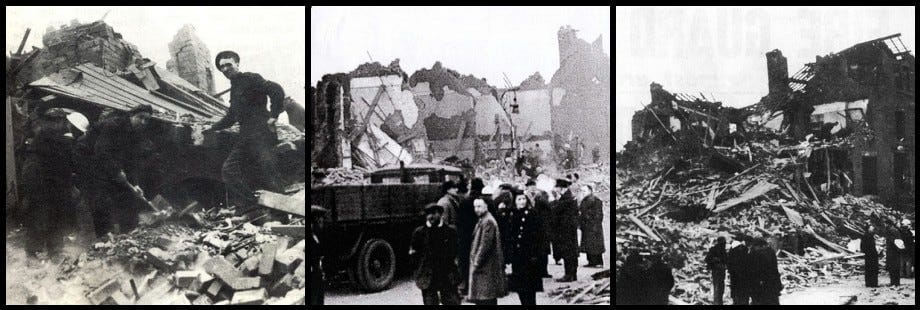
This little known “Christmas Blitz” of 1944 is what one historian calls “an act of desperation” in retaliation for Allied bombing of German cities. Because most of the original V-1 launch sites were now overrun in mainland Europe, aircraft launches were the only option available. In the words of John Delaney, a curator at the Imperial War Museum, that made them “more wildly inaccurate than normal.” If their aim point was off by even less than half a degree, by the time they were two hundred miles inland, “that would equate to sixty or seventy miles off target.”
For Margaret — who is now better known by her married name of Hodgins — it was just one of many wartime experiences. Earlier in the fighting, she recalls Manchester itself took quite a pounding over Christmas 1940. “We’d been in that Blitz and we’d moved up to Northenden,” she says. Living just off Bangor Street in Hulme, her earliest memories are of the cellar that her father — who worked for Thomas French — had lined with corrugated iron. “We used to go down when the sirens went,” she says. “If my dad wasn’t on ARP duty, he used to show silent films with Charlie Chaplin and Buster Keaton. All the neighbours used to shout down, ‘Are you showing your films tonight?’”
The last large-scale raid on Manchester had been in August 1942. For children like Margaret, they became used to the differing sounds of lone German aircraft and British ones. “There was a timebomb dropped at the school at the end of the road,” she says, “we had to move out.”
By the last winter of the war, Nazi Germany was running out of aviation fuel. Allied mastery of the skies meant that any attacks had to be mounted in the middle of the night. The V-1 was the world’s first cruise missile, admittedly a smaller, cheaper version capable of delivering nearly a ton of high explosive. The attacks had hitherto been on London and the South East, with four aimed at Southampton. Originally, the V-1s were fired off ramps but those sites in the Pas De Calais had been overrun.
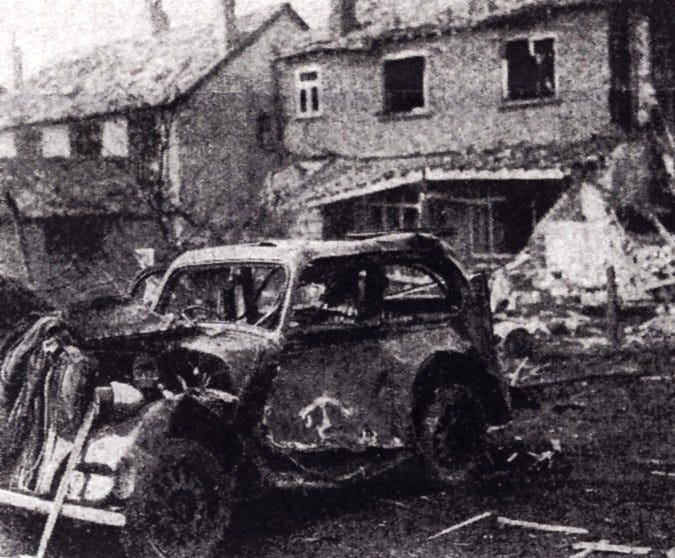
A specially trained squadron — an aerial bomb squad — was tasked to air launch the missiles. Originally based in Holland, that winter of 1944/1945 the three squadrons of Kampfgruppe KG53 had been moved back to Leck Airfield, in Schleswig Holstein. They were using Heinkel III bombers which were virtually obsolete. Allied superiority in technology and numbers meant they would rarely make it back in one piece. “The Heinkels were on their own,” says John Delaney. “The only way they could protect themselves from fighters was to attack at night.”
The records of the local air defence that Christmas Eve are revealing. At a radar station near to Lowestoft, one observer, F.J. Stott, originally from Fallowfield, watched around 5am in horror as the aircraft assembled. It was obvious his home town was the target. In the blink of an eye, all along the North Sea coast the radar traces suddenly doubled. “What was happening, of course, was they were separating as the Heinkels turned for home,” recalled another radar operator, “while the doodlebugs continued towards land, very straight and very fast.”
Those are virtually the same words Margaret uses as the V-1 she saw came to the end of its flight. “I couldn’t believe my eyes,” she says. “I have never seen anything like it.”
One puzzle is why the missile was heading in completely the opposite direction from which it was launched. “It must have made a complete 180-degree turn right at the end of its flight,” says Margaret’s son, Paul. “A few feet either way and the whole street would have been destroyed and I probably wouldn’t be here.” Likely its gyros failed at the end of the flight.
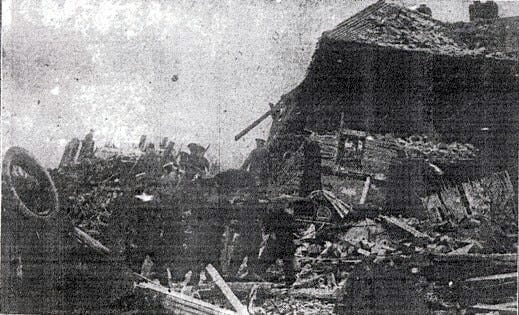
Indeed, the full story of what happened on Christmas Eve 1944 has been pieced together by people like Paul Hodgins, local historians and interested war researchers. Ian Burgess is typical, a dedicated hillwalker who is part-time detectorist and amateur detective, who has found a number of sites and debris. “On one occasion,” he says, “we have been able to find a fragment of the missile itself.” And as he has also learned his Great Uncle Amos was also bombed out in the Oldham attack.
Although in Ian’s phrase, the attacks “scared the living daylights out of people”, Mancunians knew what to do. Earlier that autumn, the Ministry of Information had made a film called “The Second Battle of Britain”, which showed what happened when the V-1 engines cut out at the end of their flight. “People would have seen that recently at their local cinemas,” says John Delaney. “That would have given them some idea of the sound.”
If there had been continuous waves of attacks, there could have been greater propaganda value in the Manchester attack. And that provides a link to one of the lesser-known reasons behind it all. “They had the ability to put a canister inside the V-1,” notes Ian Burgess. “And when the engine cut out, it was ejected.” In this case, the contents were very strange. Some were packed full of propaganda material and genuine letters from POWs, “the idea being that if someone was stupid enough to write back to them,” says John Delaney, “then the Germans would know where the V-1s had landed.”
Standing practice was that any enemy leaflets should be handled with care. “Copies of enemy propaganda leaflets are sent by the police to a bacteriological laboratory,” was the standing order to police. Which would have come as news to a group of young lads in Macclesfield Forest who later found a canister with its curious contents. They examined the material and buried it under a tree. “It’s quite tantalising,” says Mr Burgess, “that somewhere around there’s this time capsule of German propaganda that has never been examined.”

By 6.30am, the Christmas Blitz was over. Numerous families had to pick through the rubble and prepare to bury their dead. Across Greater Manchester, the festive preparations could resume. Margaret and the rest of her fellow Mancunians didn’t know it yet, but they had seen off their last raid of the war.
Photographs of Margaret provided by the Hodgins family; all others courtesy of Ian Burgess and his site aircrashsites.co.uk.
All of our journalism is made possible by our paying members, who now number just over 600. If you are able to join them, buy yourself the gift of good quality journalism by clicking below. You will get stories from us five days a week and will help us to grow our team and take on more stories in the new year.

Comments
How to comment:
If you are already a member,
click here to sign in
and leave a comment.
If you aren't a member,
sign up here
to be able to leave a comment.
To add your photo, click here to create a profile on Gravatar.

